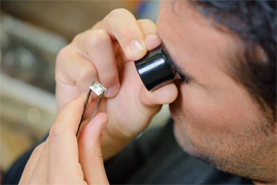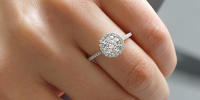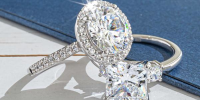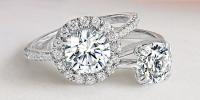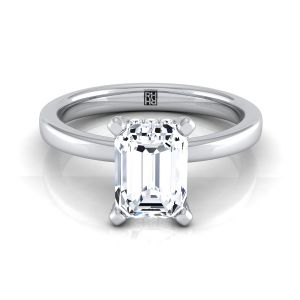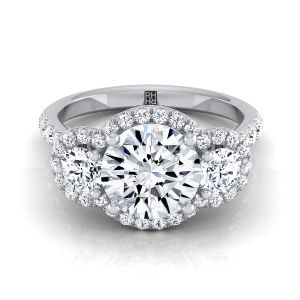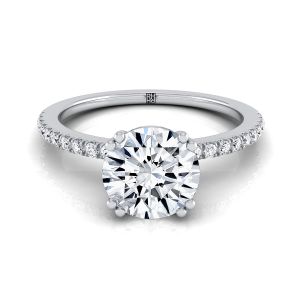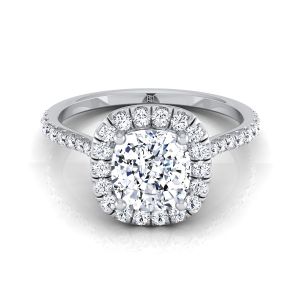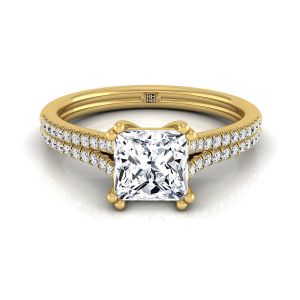June is a glorious month. In June, the days are growing longer and the weather is growing warmer. As far as astrology goes, there are two Zodiac signs celebrating June as a birth month: Gemini and Cancer.
What Is the Birthstone for June?
Pearl is the most popular
June birthstone, but it isn’t your only option. If June is your birth month, you can choose from three different birthstones:
- Pearl
- Moonstone
- Alexandrite
All About Pearl Birthstones
 Image Courtesy of Robert Weldon/GIA
Pearl
Image Courtesy of Robert Weldon/GIA
Pearl birthstones are a type of
organic gemstones made up primarily of calcium carbonate. Pearls are remarkable because living organisms create them. In contrast, many other types of gemstones are composed of minerals. Pearls can be created in both
freshwater and saltwater environments. Pearls don’t need to be cut by a lapidarist in order to be suitable for fine jewelry. However, people use a variety of other techniques to finish them including tumbling, buffing, bleaching, and dyeing. They do come in different shapes including round, oval and pear-shaped. There are also asymmetrical pearls known as “baroque pearls”.
Natural Pearls vs Cultured Pearls
Natural pearls are created without any human intervention. They form over time when an irritant enters a mollusk’s shell. Natural pearls are extremely uncommon. In contrast, humans raise some mollusks with the goal of using them to create cultured pearls. To begin the process, a person can purposefully insert an irritant such as a piece of tissue into the mollusk’s shell. Significant numbers of pearl farms exist in Australia, China's South Sea, the Philippines and Indonesia. To the naked eye, there isn’t an easily discernible difference between cultured pearls and natural pearls. However, it is possible for an educated observer to detect the difference using x-ray technology.
Pearl Colors
Pearls come in a broad variety of colors. White, cream, silver, brown and pink are all possibilities. Some Tahitian pearls are a deep, shimmery black color.
The Meaning of Pearl Birthstones
Pearls
symbolize purity. In Greek mythology, pearls are said to be the goddess Aphrodite’s calcified tears of delight. The Japanese have a similar myth -- that pearls are really water nymphs' and mermaids' tears. The Chinese associate pearls with youthfulness. This belief is so ingrained that they sometimes even grind up pearls to use in their cosmetics and lotions, in hopes that it will result in youthful looking skin. There are multiple references to pearls that survive from Biblical times. One of the most memorable is the
parable of the pearl from the gospel of Matthew:
"Again, the kingdom of heaven is like unto a merchant man, seeking goodly pearls: Who, when he had found one pearl of great price, went and sold all that he had, and bought it." — Matthew 13:45-46, King James Version
Value of Pearls
There are multiple factors that can affect
pearl values. The most important criteria for pearl valuation is whether the pearl is natural or cultured. Natural pearls command much higher prices. The second most important factor is luster. A perfectly lustrous pearl will fetch a much higher price than a dull pearl. Size is another factor that can affect value significantly. Large pearls are rare and desirable; people are often willing to pay higher prices for them. Perfectly round pearls are not easy to find, so they tend to be more valuable than pearls that have clearly asymmetrical shapes. Other factors that affect pearl value are surface quality, nacre quality, and color.
Related: Click Here to Buy June Birthstone Earrings.
All About Alexandrite Birthstones
 Image Courtesy of Robert Weldon/GIA
Alexandrite
Image Courtesy of Robert Weldon/GIA
Alexandrite is an intriguing type of
chrysoberyl that has the ability to change colors, and chrysoberyl is a type of
colored gemstone with a chemical composition of BeAl2O4. The story surrounding alexandrite's discovery is controversial. Its revelation is attributed to
Nils Gustaf Nordenskiöld, a Finnish mineralist who was working in the emerald mines of the Ural mountains. Supposedly, Nordenskiöld made the alexandrite discovery in 1834 on the birthday of Russia's Alexander II. According to the story, he then decided to name the stone after Alexander II. Because the green color of the stone was similar to that of an emerald, it was initially mistaken for an emerald.
Alexandrite Colors
Alexandrite changes color when viewed under different light sources. In daylight, alexandrite can display as green or a bluish tinted green. Under an incandescent light source, alexandrite can display either as red or a purplish red.
Alexandrite is mined from multiple countries including Russia, Sri Lanka, Southern Tanzania and others. The source of the alexandrite can influence the gemstone’s colors. For example, the colors exhibited in Russian alexandrite tend to be superior to those in Sri Lankan alexandrite.
The Meaning of Alexandrite Birthstones
Alexandrite stones have been associated with just about every positive quality you could think of. However, their primary association is with prosperity. Alexandrite is said to bring good fortune to its owner. It is also believed to strengthen its owner’s aura and increase her potential for attracting success and wealth.
Value of Alexandrite
Multiple factors influence
alexandrite values. For starters, all alexandrite is relatively rare, so values tend to be higher for alexandrite stones than they are for many other types of comparable cut and polished colored gemstones. A primary selling point of an alexandrite stone is its ability to
change colors. An alexandrite that changes color dramatically tends to be more valuable than an alexandrite that shifts color subtly.
All About Moonstone Birthstones
 Image Courtesy of GIA
Moonstone
Image Courtesy of GIA
Moonstone is a shimmery-looking mineral from the
feldspar family. The Roman naturalist and historian,
Pliny the Elder, is said to have named moonstone. He chose that name because he believed the phases of the moon affected the stone's appearance. There are deposits of moonstone scattered in multiple locations across the globe. Currently, Sri Lanka and India are the most plentiful sources of moonstone. This mineral is also being mined in the United States, Australia, Brazil, Mexico, and Tanzania.
Moonstone Colors
Blue is one of the most popular moonstone colors. Moonstones are also available in a lively palette of other hues including colorless, white, gray, green, brown, purple and pink.
The Meaning of Moonstone Birthstones
Moonstones are said to enable protection for those who carry them when traveling on moonlit nights. There’s also a widespread belief that they can help to empower love and fertility. In India, moonstones are popular wedding gifts because of these connections.
Value of Moonstone
The two most
valuable types of moonstone are the highly transparent, colorless variety and the intensely blue colored variety. These both tend to command higher prices than other moonstones of comparable size. Vintage moonstone from Myanmar is particularly prized. It is common for moonstones to have inclusions, but fewer numbers of inclusions make for more desirable and valuable stones. So there you have it: Pearls, moonstones, and alexandrite are your 3 choices for June birthstones. Any of these 3 stones would be the perfect gift for a Gemini’s or Cancer’s birthstone jewelry in the month of June this year.
 Image Courtesy of Robert Weldon/GIA
Pearl birthstones are a type of organic gemstones made up primarily of calcium carbonate. Pearls are remarkable because living organisms create them. In contrast, many other types of gemstones are composed of minerals. Pearls can be created in both freshwater and saltwater environments. Pearls don’t need to be cut by a lapidarist in order to be suitable for fine jewelry. However, people use a variety of other techniques to finish them including tumbling, buffing, bleaching, and dyeing. They do come in different shapes including round, oval and pear-shaped. There are also asymmetrical pearls known as “baroque pearls”.
Image Courtesy of Robert Weldon/GIA
Pearl birthstones are a type of organic gemstones made up primarily of calcium carbonate. Pearls are remarkable because living organisms create them. In contrast, many other types of gemstones are composed of minerals. Pearls can be created in both freshwater and saltwater environments. Pearls don’t need to be cut by a lapidarist in order to be suitable for fine jewelry. However, people use a variety of other techniques to finish them including tumbling, buffing, bleaching, and dyeing. They do come in different shapes including round, oval and pear-shaped. There are also asymmetrical pearls known as “baroque pearls”.
 Image Courtesy of Robert Weldon/GIA
Alexandrite is an intriguing type of chrysoberyl that has the ability to change colors, and chrysoberyl is a type of colored gemstone with a chemical composition of BeAl2O4. The story surrounding alexandrite's discovery is controversial. Its revelation is attributed to Nils Gustaf Nordenskiöld, a Finnish mineralist who was working in the emerald mines of the Ural mountains. Supposedly, Nordenskiöld made the alexandrite discovery in 1834 on the birthday of Russia's Alexander II. According to the story, he then decided to name the stone after Alexander II. Because the green color of the stone was similar to that of an emerald, it was initially mistaken for an emerald.
Image Courtesy of Robert Weldon/GIA
Alexandrite is an intriguing type of chrysoberyl that has the ability to change colors, and chrysoberyl is a type of colored gemstone with a chemical composition of BeAl2O4. The story surrounding alexandrite's discovery is controversial. Its revelation is attributed to Nils Gustaf Nordenskiöld, a Finnish mineralist who was working in the emerald mines of the Ural mountains. Supposedly, Nordenskiöld made the alexandrite discovery in 1834 on the birthday of Russia's Alexander II. According to the story, he then decided to name the stone after Alexander II. Because the green color of the stone was similar to that of an emerald, it was initially mistaken for an emerald.
 Image Courtesy of GIA
Moonstone is a shimmery-looking mineral from the feldspar family. The Roman naturalist and historian, Pliny the Elder, is said to have named moonstone. He chose that name because he believed the phases of the moon affected the stone's appearance. There are deposits of moonstone scattered in multiple locations across the globe. Currently, Sri Lanka and India are the most plentiful sources of moonstone. This mineral is also being mined in the United States, Australia, Brazil, Mexico, and Tanzania.
Image Courtesy of GIA
Moonstone is a shimmery-looking mineral from the feldspar family. The Roman naturalist and historian, Pliny the Elder, is said to have named moonstone. He chose that name because he believed the phases of the moon affected the stone's appearance. There are deposits of moonstone scattered in multiple locations across the globe. Currently, Sri Lanka and India are the most plentiful sources of moonstone. This mineral is also being mined in the United States, Australia, Brazil, Mexico, and Tanzania.











